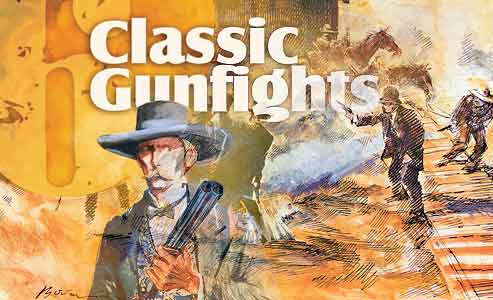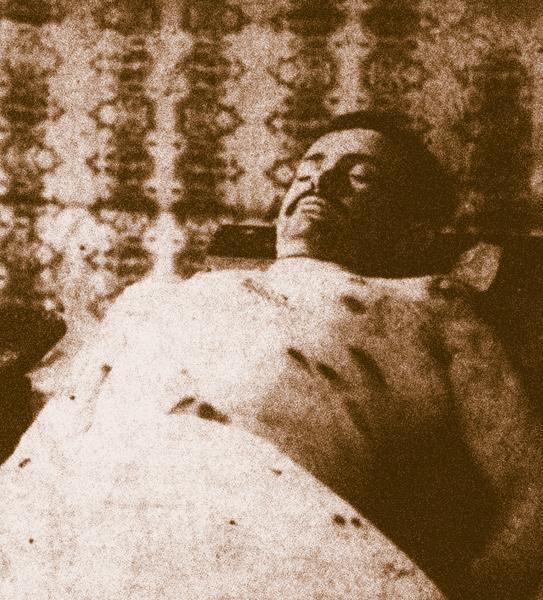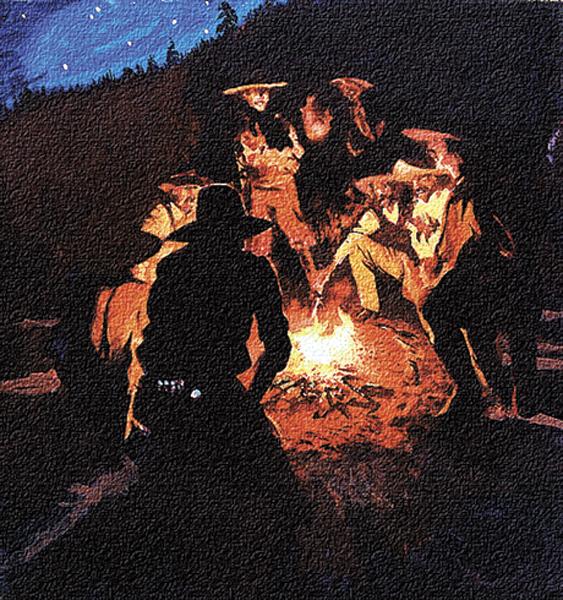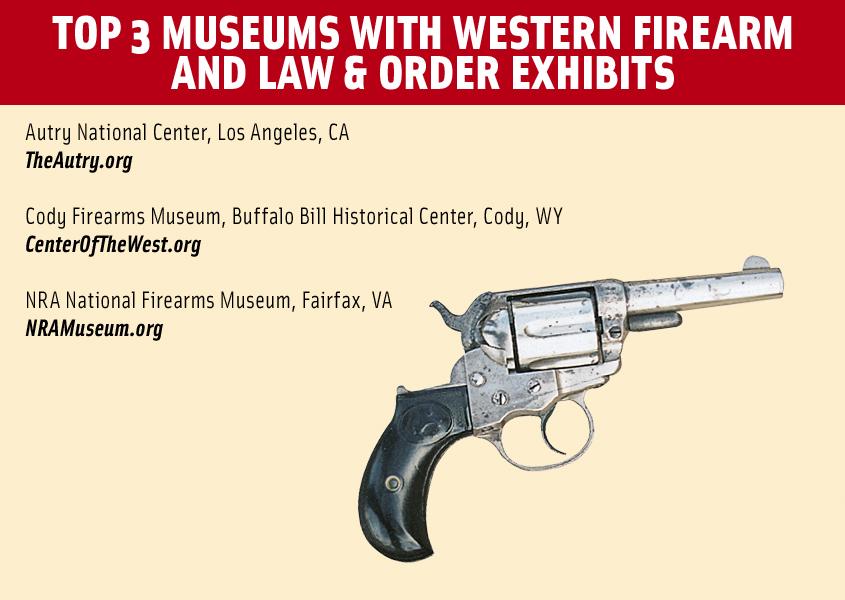 When Kurt Russell as Wyatt Earp utters his death-defying oath, “You tell ’em I’m coming, and Hell is coming with me, you hear!” with Biblical conviction in the film Tombstone, you know that your bucket-list must include a walk down the boardwalks of Tombstone to the back of the O.K. Corral to witness where the dirt and manure were soaked red with blood.
When Kurt Russell as Wyatt Earp utters his death-defying oath, “You tell ’em I’m coming, and Hell is coming with me, you hear!” with Biblical conviction in the film Tombstone, you know that your bucket-list must include a walk down the boardwalks of Tombstone to the back of the O.K. Corral to witness where the dirt and manure were soaked red with blood.
Every month, Executive Editor Bob Boze Bell details a great Western gunfight, with the nitty-gritty details, maps, photos, art and insights that you can get nowhere else but in True West magazine.
Pull on your boots, grab your hat and let’s re-discover six of Bob Boze Bell’s greatest “Classic Gunfights.”
—Stuart Rosebrook
THREE MEN HURLED INTO ETERNITY
Shoot-out Behind the O.K. Corral: The Earps and Doc Holliday vs the Clantons and the McLaurys, Tombstone, Arizona, October 26, 1881
“Come along,” Virgil Earp says, handing a Wells Fargo shotgun to Doc Holliday. The quartet, including Wyatt Earp, Morgan Earp, Virgil Earp and Doc Holliday, starts up Fourth Street in Tombstone, walking four abreast, but when they turn the corner at Fremont Street, they walk two by two, favoring the south sidewalk.
Striding purposefully past the rear entrance to the O.K. Corral, the men see Cochise County Sheriff John Behan coming toward them. “Hold up boys; don’t go down there or there will be trouble!”
Virgil is firm about enforcing the ordinance banning guns within the city limits. “Johnny, I am going down to disarm them,” he tells the sheriff.
“I have been down there to disarm them!” Behan cries. Both Wyatt and Virgil resheath their weapons. In spite of Behan’s claim, they continue on, perhaps to meet their tormentors face-to-face and tell them off.
But as they step into the lot, it is
apparent that Behan was not quite telling the truth. Both Billy Clanton and Frank McLaury wear holsters with their pistols in plain sight.
“Boys, throw up your hands,” Virgil demands. “I want your guns.”
Nervous about the confrontation and sensing the bristling attitude of Morgan Earp and Doc Holliday, Frank McLaury says, “We will,” and makes a motion to pull his revolver. Holliday makes a sudden move toward Tom McLaury, thrusting the shotgun at him in a threatening manner. Wyatt Earp jerks his pistol from his coat pocket, and Billy Clanton pulls his revolver.
“Hold on, I don’t want that!” says Virgil, realizing the situation is slipping from his control.
Two shots ring out, almost as one. Then a long pause. Frank McLaury clutches his stomach and staggers as the firing continues. Ike Clanton flees once the shooting starts.
Some 30 shots are fired in less than 30 seconds. The most famous and the most over-analyzed fight in the West is over. The repercussions are only beginning.
BULLETS CAREEN INTO THE LONG BRANCH
Battle of the Plaza: Bat Masterson vs Peacock & Updegraph, Dodge City, Kansas, April 10, 1881
Traveling mostly by rail, Bat Masterson has just covered 1,100 miles to come to the aid of his estranged brother, Jim. Masterson was in Tombstone, Arizona Territory, with Wyatt Earp, when he received word of threats against his brother’s life.
As the Dodge City-bound train pulls into the depot from the west, Masterson swings down off the train on the north side of the tracks. It is about noon. His intuition tells him his brother’s enemies may attempt to round him up at the depot.
He scans the train platform and the busy streets looking for trouble. As the caboose passes, he notices two men on the opposite side of the tracks, walking toward the depot.
Masterson immediately recognizes the men and shouts, “Hold up there a minute, you two! I want to talk to you.”
Saloon owner A.J. Peacock and his brother-in-law, bartender Al Updegraph, take one look at the familiar stocky figure striding toward them and turn on their heels, ducking behind the corner of the jail.
All parties pull weapons and begin to bang away at each other. Masterson retreats to the railroad track’s three-foot berm and hides behind it.
Bullets snap over Masterson’s head and thud in Dr. McCarty’s drugstore on the north side of Front Street. Masterson returns fire, knocking huge splinters of wood from the corner of the hoosegow.
Bullets careen into the Long Branch Saloon, sending patrons scrambling out the back door. Owner Chalk Beeson seeks refuge behind the door of his safe. George Hoover’s saloon loses a window, and a bullet tears a newspaper from an idler’s hand.
Amidst the wild firing, Updegraph suddenly pitches forward as a bullet rips through his chest. Not long after, Bat Masterson and Peacock run out of bullets. Mayor Ab Webster runs up and sticks a Fox shotgun barrel in Masterson’s face.
Learning from the mayor that his brother is alive, Masterson surrenders and hands over his empty six-guns.
TUMBLING DICE EARNS HARDIN A ONE-WAY TICKET TO HELL
John Wesley Hardin vs Constable John Selman, El Paso, Texas, August 19, 1895
Wes Hardin is drunk and furious. “I’ll go and get a gun,” he bel-lows at John Selman, Sr., “and when I meet you, I’ll meet you smoking, and make you shit like a wolf around the block!” The two part ways.
Later that night, Hardin is standing at the bar, just inside the front door of the Acme Saloon in El Paso, Texas, rolling dice for drinks with a local grocer. According to the clock on the wall, it is the eleventh hour, but for the aging gunfighter, the seconds are ticking to eternity.
“It was a hot night,” Patrick McGeeney later testifies, “sultry, with heavy humidity.” Two old cattlemen are seated at a nearby table in the smoky din, relating the adventures they’d had with Cochise, Geronimo, John Ringo, Pat Garrett and Billy the Kid.
“Hoss piss on you,” bellows Hardin, grumbling at the ivory numerical combin-ations on the bar.
“Shake again,” the grocer grunts.
“You have four sixes to beat,” says Hardin, as the dice tumble to a stop on the hardwood bar top.
Stepping through the swinging doors, John Selman, Sr. fires his pistol. The bullet enters the back of Hardin’s head, exits above his left eye and hits the mirror behind the bar, shattering it. Crumpling to the floor, Hardin falls face up. Selman steps over him and fires three more times, hitting Hardin in the chest and taking the tip off the gunfighter’s pinkie on his left hand.
As patrons clamber for the exits, Constable John Selman, Jr. runs in and grabs his dad’s arm, saying, “Don’t shoot anymore! He’s dead!”
That’s how Hardin died.
SHOOT-OUT AT BLAZER’S MILL
Buckshot Roberts vs The Regulators, Mescalero Apache reservation, New Mexico, April 4, 1878
Coming in from the south, Buckshot Roberts is unaware of The Regulators as he approaches Blazer’s Mill.
Roberts reins in at the corner of the agency’s office and tethers his mule. He carries his .44 Winchester into the post office. As Middleton eavesdrops on the stranger, he overhears the name Roberts. He then slips into the dining room and tells his captain, Richard Brewer, who says, “I’ve got a warrant for him.”
Regulator Frank Coe, a friend and neighbor, comes outside to talk Roberts into surrendering. Roberts asks Coe to go inside and look at a Las Cruces newspaper, claiming it will exonerate him from the warrant charges.
But Coe decides against it.
Instead, the two of them sit on the stoop. For half an hour, Coe begs Roberts to surrender, “but the answer [is] ‘no, no, no.’”
Worrying that Roberts could be using Coe as a hostage, Brewer asks for volunteers to end the stalemate. Charlie Bowdre steps forward, followed by John Middleton, Frank MacNab, Henry Brown, George Coe (Frank’s cousin), Doc Scurlock and Billy Kid Bonney.
With Bowdre in the lead, The Regulators cock their guns, and as they turn the corner of the house, Bowdre sees Roberts’ cocked rifle lying in his lap. Bowdre points his gun at Roberts and commands him to “throw up his hands.”
Rising to his feet, Roberts faces his adversaries and cryptically says, “Not much, Mary Ann.”
Roberts and Bowdre fire at the same time. Roberts’ first bullet hits Bowdre’s belt buckle and knocks his gun belt to the ground. The same bullet then ricochets into George Coe’s gun hand, mangling his trigger finger.
Bowdre’s bullet hits Roberts just below the belly. Roberts staggers backwards, still firing rapidly.
Roberts’ next bullet nails Middleton in the chest, just missing his heart. Another hits Scurlock’s holstered pistol and courses down his leg. Billy Bonney is “shaved” in the arm.
As The Regulators stumble for cover, Robert retreats into Dr. Blazer’s office. Roberts’ Winchester is empty, so he grabs a single-shot, 1872 officer’s model .45-70 Springfield rifle off the wall and takes up position behind the mattress he has put against the door.
After spotting the puff of smoke from Brewer’s gun, Roberts guesses the trajectory and waits to see Brewer’s head poke up. He lets loose with the big Springfield. His slug hits Brewer’s left eye, and blows out the back of his skull.
With three men severely wounded and their leader slain, The Regulators flee over the mountains for the Ruidoso Valley.
INGALLS’ ONSLAUGHT TURNS BLOODY
Doolin-Dalton Gang vs Stillwater Marshals, Ingalls, Oklahoma Territory, September 1, 1893
Three covered wagons full of federal marshals approach the outlaw village of Ingalls, Oklahoma Territory.
A group of marshals led by Tom Hueston takes up positions behind the Ransom Saloon to block any outlaws from retreating.
One of the lawmen shouts, “You are surrounded—surrender!”
Bill Doolin replies, “Go to hell!”
The marshals answer with a withering barrage of lead. The outlaws head into a half-finished shed on the south side of the saloon. Moments later, they bolt from the shed and dash to the livery stable to the south. The lawmen are unaware the outlaws have deserted the saloon, until they are fired at from the stable.
Unable to see the action from his hotel room, Arkansas Tom punches holes in the roof and, using a chair or some other article of furniture, gains enough height to shoot down on the exposed lawmen. His deadly fire hits Hueston.
In the stable, Bill Dalton and Tulsa Jack Blake keep up a close, accurate fire from the doorway, while Doolin and Dynamite Dick Clifton saddle
the horses.
The lawmen return fire, with Deputy Marshal John Hixon pumping shot after shot into the stable doorway. Deputy Sheriff Jim Masterson (brother of Bat) fires from behind a tree that is “little more than half as thick as his body.” Outlaw lead pummels its trunk, cutting off limbs and “tearing holes in the ground all about him.” Masterson “stands his ground until his ammunition [is] exhausted.”
As the lawmen try to gain better positions, the four outlaws break from the stable on horseback, with Dalton and Tulsa Jack coming out the front, and Doolin and Dynamite Dick out the back, “riding hell-bent south and west toward a draw.”
Marshal Hixon takes a bead on one of the fast-moving targets and shoots, hitting Dalton’s horse in the jaw. Horse and rider spin like a merry-go-round gone berserk. Another marshal fires and hits Dalton’s horse in the leg, causing both rider and horse to go down.
Shooting from his rooftop sniper nest, Arkansas Tom strikes again, hitting Officer Lafe Shadley, who is already down on the ground because his coat is stuck in a barbed-wire fence.
Dalton cuts the fence and the outlaws disappear into a ten-foot draw. “They [come] out of the gully on the jump,” Masterson later recounts. “Dalton [is] up behind Doolin … Well, we [blaze] away at ’em and Dalton [tumbles] off. They [stop, lift] him in the saddle, and Doolin [gets] up behind. I [raise] my sight to 500 yards, but I [can’t] get ’em.” (It is later learned that Dynamite Dick, not Dalton, fell off from a shot to the neck.)
After a long standoff at the hotel, Arkansas Tom finally surrenders to a local preacher on the condition he not be lynched. Considering the mayhem he had caused, it’s a wonder the marshals honor his request, but they do.
ROCK CREEK KILLFEST
James Butler Hickok vs David McCanles, Rock Creek, Nebraska, July 12, 1861
David McCanles, his son William and two employees ride up to Rock Creek Station, Nebraska Territory. Leaving his two hired hands at the barn, McCanles and his son go over to the main house and demand that the occupants clear out.
The Pony Express Station keeper Horace Wellman tells McCanles he has no such authority. An argument ensues and a frightened Wellman retreats into the house while Jane, Wellman’s common-law wife, stands outside the doorway and berates McCanles for thrashing her father earlier over an alleged theft.
James Hickok (not yet Wild Bill) appears in the doorway and is advised by McCanles to keep away.
A known bully, McCanles is usually armed with a pistol and shotgun. (It is hotly debated whether he was so armed that day.) To gain time, he asks Hickok for a drink of water. Hickok steps inside to get it. Moments later, a shot is fired from within the house and McCanles collapses.
James Woods and James Gordon, McCanles’ two employees, rush up from the barn and are both shot, though not fatally. Jane Wellman supposedly takes a hoe and smashes Woods’ skull, perhaps aided by her still-frightened husband.
Gordon manages to escape into the brush, but his bloodhound follows him, and his pursuers follow his blood and the dog. Gordon is easily found and killed with a shotgun blast, supposedly by Pony Express rider James W. “Doc” Brink.
McCanles’ son William runs to his father’s side, but he’s driven away by Jane Wellman. The boy escapes into the brush and makes it to safety.
Photo Gallery
The Blazers lived in a large, two-story adobe (left) north of the agency building. Some believe this structure housed Blazer’s “office” and that Buckshot Roberts took refuge here before dying.
The doctor will see you now.
– All illustrations by Bob Boze Bell –
Roy Daugherty Alias “Arkansas Tom” Jones, bank robber born in Missouri, but claims to have come from Arkansas.
Bat Masterson traveled the West as a gambler after he lost his re-election bid for sheriff of Ford County, Kansas, in 1879.
– Courtesy Robert G. McCubbin Collection –
– Courtesy Robert G. McCubbin Collection –
“Bitter Creek” Newcomb 27, train robber gets his nickname from boasting, “I’m a bad man from Bitter Creek, and it’s my night to howl!”
Indian Agent Frederick Godfroy, his wife Clara and their two daughters occupied the big house in the photo at right (dark building with cupola right of center). Clara took in lodgers and served meals to travelers, requiring all to leave their arms outside the house or on a table in the doorway. Brewer and The Regulators adhered to the gun rule, but posted John Middleton as a lookout.
– Photos Courtesy University of Arizona Library Special Collections –
The evening before the fight, the Regulators spent the night up in the pines of the Sacramento Mountains.
– Art by Bob Boze Bell –
David McCanles
Bill Doolin 36, 6’ 2”, 150 pounds, bank and train robber plans his jobs well.
Bill Dalton 30, train robber is one of 15 children, two of whom were killed; another was captured at Coffeyville, Kansas, the previous year.
– Photos Courtesy John Boessenecker, Robert G. McCubbin and Glenn Shirley –
William Blake Alias “Tulsa Jack,” cowboy, rail hand, gambler and train robber was husky, dark-faced and heavily mustached.
Dodge City Peace Commission, 1883
Two years after the gunfight in Dodge City, Kansas, this famous photo of the Dodge City Peace Commission will be taken. Front row (from left): Charlie Bassett, Wyatt Earp, W.F. McLain and Neil Brown. Back row (from left): W.H. Harris, Luke Short, Bat Masterson and W.F. Petillon.
– Courtesy Jeff Morey –
Dan CliftonAlias “Dynamite Dick,” cattle rustler and whiskey peddler, hollows the lead points of his cartridges and fills them with dynamite.
The Fremont Street confrontation has been brewing for some time as the Earps and Holliday finally give Ike Clanton his wish: “All I want is four feet of ground.”
After Hardin is killed, his body is removed to the undertakers, who clean and prepare it for photographing and burial.
– Courtesy Robert G. McCubbin Collection –
James Butler Hickok This 1863 photo shows how Wild Bill probably looked at the time of the McCanles shootout. Hickok was attracted to McCanles’ mistress, Sarah Shull (next slide), undoubtedly contributing to the friction between the men.
– Courtesy Robert G. McCubbin Collection –
John Selman, as he probably looked when he shot Wes Hardin, used a cane after being shot in the leg by Bass Outlaw.
– True West Archives –
Rock Creek Station A regular camping spot on the Oregon Trail, Rock Creek was first known as Weyth Creek (see c. 1861 photo of Rock Creek Station, above). Rock Creek “cut and intersected with deep, irregular gorges and canyons, through which flow crystal streams, fed by the springs that issue from the walls of rock under the hills. Giant oaks, elms and cottonwoods studded the banks of these streams, and the little flats in the bends of its winding course, rank in growth or primitive grasses, with the hillsides surrounding clothed with the shorter grasses suitable for pasturage,” so wrote Charles Dawson in 1912.
– True West Archives –
Sarah Shull
– True West Archives –
John Wesley Hardin was already an established killer at age 18.
– Courtesy Robert G. McCubbin Collection –





































